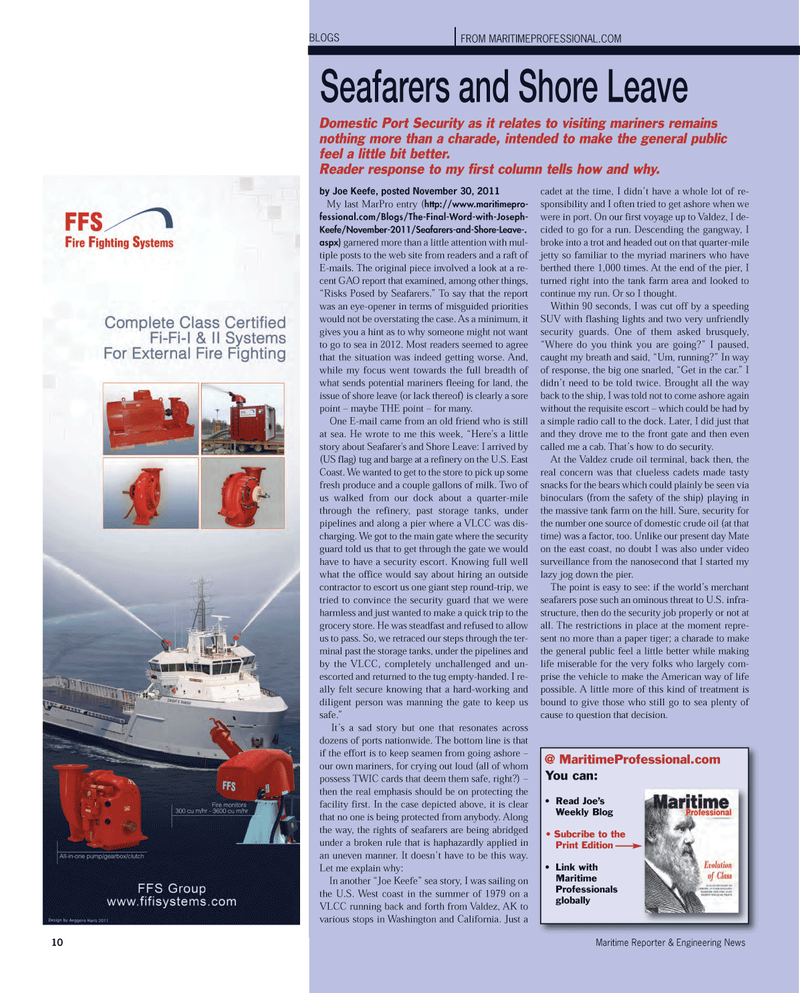
Page 10: of Maritime Reporter Magazine (December 2011)
Great Ships of 2011
Read this page in Pdf, Flash or Html5 edition of December 2011 Maritime Reporter Magazine
10Maritime Reporter & Engineering News BLOGSFROM MARITIMEPROFESSIONAL.COMby Joe Keefe, posted November 30, 2011My last MarPro entry (http://www.maritimepro- fessional.com/Blogs/The-Final-Word-with-Joseph- Keefe/November-2011/Seafarers-and-Shore-Leave-. aspx) garnered more than a little attention with mul- tiple posts to the web site from readers and a raft ofE-mails. The original piece involved a look at a re- cent GAO report that examined, among other things, ?Risks Posed by Seafarers.? To say that the report was an eye-opener in terms of misguided priorities would not be overstating the case. As a minimum, it gives you a hint as to why someone might not want to go to sea in 2012. Most readers seemed to agreethat the situation was indeed getting worse. And, while my focus went towards the full breadth of what sends potential mariners fleeing for land, theissue of shore leave (or lack thereof) is clearly a sore point ? maybe THE point ? for many. One E-mail came from an old friend who is stillat sea. He wrote to me this week, ?Here's a littlestory about Seafarer's and Shore Leave: I arrived by (US flag) tug and barge at a refinery on the U.S. East Coast. We wanted to get to the store to pick up some fresh produce and a couple gallons of milk. Two of us walked from our dock about a quarter-mile through the refinery, past storage tanks, under pipelines and along a pier where a VLCC was dis- charging. We got to the main gate where the security guard told us that to get through the gate we would have to have a security escort. Knowing full well what the office would say about hiring an outside contractor to escort us one giant step round-trip, wetried to convince the security guard that we were harmless and just wanted to make a quick trip to the grocery store. He was steadfast and refused to allow us to pass. So, we retraced our steps through the ter- minal past the storage tanks, under the pipelines andby the VLCC, completely unchallenged and un- escorted and returned to the tug empty-handed. I re-ally felt secure knowing that a hard-working and diligent person was manning the gate to keep us safe.? It?s a sad story but one that resonates across dozens of ports nationwide. The bottom line is that if the effort is to keep seamen from going ashore ? our own mariners, for crying out loud (all of whom possess TWIC cards that deem them safe, right?) ? then the real emphasis should be on protecting thefacility first. In the case depicted above, it is clear that no one is being protected from anybody. Along the way, the rights of seafarers are being abridged under a broken rule that is haphazardly applied in an uneven manner. It doesn?t have to be this way. Let me explain why: In another ?Joe Keefe? sea story, I was sailing on the U.S. West coast in the summer of 1979 on a VLCC running back and forth from Valdez, AK to various stops in Washington and California. Just a cadet at the time, I didn?t have a whole lot of re- sponsibility and I often tried to get ashore when wewere in port. On our first voyage up to Valdez, I de- cided to go for a run. Descending the gangway, I broke into a trot and headed out on that quarter-mile jetty so familiar to the myriad mariners who have berthed there 1,000 times. At the end of the pier, I turned right into the tank farm area and looked to continue my run. Or so I thought.Within 90 seconds, I was cut off by a speeding SUV with flashing lights and two very unfriendly security guards. One of them asked brusquely, ?Where do you think you are going?? I paused,caught my breath and said, ?Um, running?? In way of response, the big one snarled, ?Get in the car.? I didn?t need to be told twice. Brought all the way back to the ship, I was told not to come ashore again without the requisite escort ? which could be had bya simple radio call to the dock. Later, I did just that and they drove me to the front gate and then even called me a cab. That?s how to do security. At the Valdez crude oil terminal, back then, the real concern was that clueless cadets made tasty snacks for the bears which could plainly be seen viabinoculars (from the safety of the ship) playing inthe massive tank farm on the hill. Sure, security for the number one source of domestic crude oil (at thattime) was a factor, too. Unlike our present day Mate on the east coast, no doubt I was also under video surveillance from the nanosecond that I started my lazy jog down the pier. The point is easy to see: if the world?s merchant seafarers pose such an ominous threat to U.S. infra- structure, then do the security job properly or not atall. The restrictions in place at the moment repre- sent no more than a paper tiger; a charade to make the general public feel a little better while makinglife miserable for the very folks who largely com- prise the vehicle to make the American way of life possible. A little more of this kind of treatment is bound to give those who still go to sea plenty of cause to question that decision. Seafarers and Shore Leave Domestic Port Security as it relates to visiting mariners remains nothing more than a charade, intended to make the general public feel a little bit better. Reader response to my first column tells how and why. @MaritimeProfessional.com You can: Read Joe?s Weekly Blog Subcribe to the Print EditionLink with Maritime Professionals globallyMR Dec.11 # 2 (10-17):MR Template 12/6/2011 4:39 PM Page 10

 9
9

 11
11
